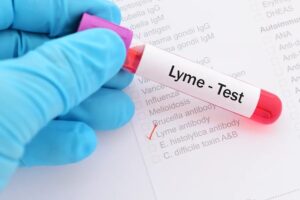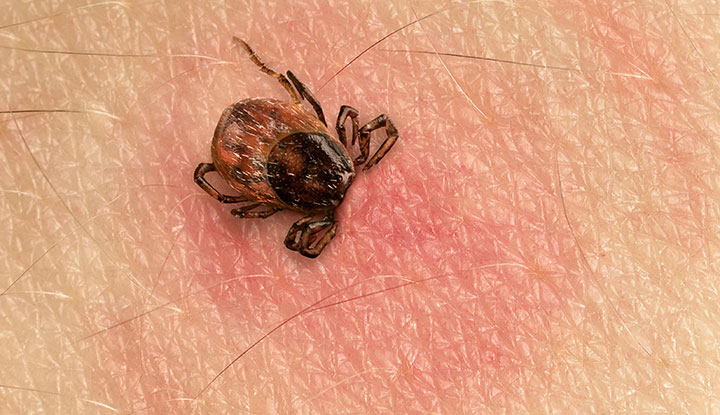Can You Get Lyme Without a Rash? Why the “Bullseye” Myth Is Misleading
When someone gets bitten by a Lyme-infected tick, the first symptom is more often than not a bullseye rash. According to data published by Dartmouth University, about 50% of the ticks in the Northeast carry Lyme disease.
Lyme disease is also present in other areas, but the chances of contracting it are drastically lower.
According to the CDC, 282 out of 10,000 visits to the Northeast ER rooms in May 2025 were a result of tick bites. However, most of them showed up because they saw the rash and grew concerned.
Many did not see the rash, so they did not feel the need to visit the ER. This gave Lyme disease time to spread since the appropriate treatment was not given.
This article will cover more aspects of the bullseye rash and how many people get one. Patients should learn to track other symptoms in case the typical rash doesn’t show.
How Common Is the Bullseye Rash?
The bullseye rash is a common symptom that affects two-thirds of people bitten by an infected tick. The bullseye rash is one of the first symptoms of Lyme disease infection.
Most associate the symptom with the presence of Lyme, but infestation frequently occurs even without the rash.
What Is Erythema Migrans?
Erythema Migrans, also known as the classic bullseye rash, is a key diagnostic element of Lyme disease. The rash appears in the tick bite area and looks like a target, or a “bullseye.”
It has a red circular, reddish lesion around the bite, a central clearing, and a red ring on the outside.
The rash is rarely painful but can feel warm to the touch. It appears about 3 to 30 days after getting bitten by the tick, expanding gradually.
Not all Lyme rashes look like a bullseye. Other atypical Lyme rash types include the following:
- A uniform and solid red patch with no central clearing
- A blotchy rash with irregular borders, often mistaken for eczema
- An elongated or oval rash
- A purple-ish, bruise-like discoloration (frequent in dark-skinned people)
- Multiple small rashes, often confused with hives
- Raised or swollen appearance
- Burning or itchy rash
- Dry or scaly rash that resembles psoriasis
Because of its atypical shape, many dismiss the rash, along with the early symptoms of Lyme disease. Conventional doctors mistake it for a benign skin condition. Always consider the possibility of Lyme in “hot zones,” even if the rash looks odd.
According to data from the CDC, only around 70-80% of patients with Lyme develop a rash. Studies by Steven E. Schutzer at the University of Medicine and Dentistry of New Jersey on Lyme disease rashes showed that 25% to 30% of patients get the atypical form.
This means that 20-30% of people do not get a rash at all. This causes patients to miss the treatment “window,” which is essential for Lyme disease. Patients should get the appropriate Lyme treatment once the symptoms appear.
Why Many Lyme Cases Happen Without a Rash
Many Lyme cases happen without a rash because of the delayed response of the immune system. Borrelia burgdorferi has evolved sufficiently to be able to stay hidden. This keeps the immune system from reacting the way it normally would.
Borrelia’s Immune Evasion and Host Response
Up to 30% of Lyme disease patients do not get a rash because the Lyme-causing bacteria have learned to evade the immune system.
When a blacklegged (or other infected) tick sends the bacteria into the body, it responds by triggering inflammation. This creates redness, swelling, and the potential rash.
The problem is that Borrelia burgdorferi is very good at immune suppression and interferes with the signals that your immune system sends. This includes the release of cytokines, the protein that causes the actual inflammation.
The immune system delays the reaction, which means that patients won’t show any visible signs on the skin.
Patients with compromised immune systems let the bacteria “slip” past the bite site immediately. This causes the body to miss the signals entirely as the infection outsmarts the body’s defenses in its initial stages.
What Are the Risk Factors for Rash-Free Infection?
Several factors, such as the timing of the bite, your skin color, or the stage of the tick, affect whether or not you get a rash. Here is how they influence how the body responds:
- Bite Timing: Tick bites that happen overnight often go unnoticed. The tick could attach, feed, and then detach itself without you noticing. Since you likely didn’t scratch or see the area, the bite goes undetected.
- Visibility and Skin Color: Rashes are not as visible on darker skin tones, with many mistaking them for a bruise. Some ticks bite behind the knee, on the scalp, or along the waistline, causing them to go undetected.
- Tick Stage: Nymphal ticks are smaller and go undetected most of the time, increasing the chances of infection. Their feeding stage could also influence how much saliva proteins they release, as they suppress the immune system.
When these situations happen, patients develop systemic symptoms as noted below. However, since there’s no visible rash, many mistake it for the common cold, flu or just having an “off” day.
Symptoms to Watch for If You Never Saw a Rash
Lyme disease is frequently accompanied by symptoms such as joint pain, neck pain, fatigue, headaches, and even sometimes gastrointestinal stress. These resemble the flu and appear after a tick bite without the rash.
Flu-Like Symptoms in Early Disseminated Lyme
Many patients experience early symptoms that mimic the flu. Left unattended, Lyme spreads and affects the rest of your body. These signs include the following:
- Fatigue at any time of the day
- Chills and fever
- Joint pain
- Headaches
- Stiff neck
- Swollen lymph nodes
- Vision changes
- Weakness in the arms or legs
These symptoms occur with or without a rash. This leads to delayed treatment, which can cause chronic Lyme.
Studies published by the CDC on Lyme disease show that 8% to 12% treatments fail due to the delay. This leads to a condition referred to as post-treatment Lyme disease syndrome.
Testing Challenges When No Rash Is Present
Diagnosis becomes significantly harder when no rash is present due to symptom overlap and weak immune response.
Many patients who are unaware of the bite treat the symptoms with cold medicine. No inflammation also leads to minimal data, causing lab tests to become inconclusive.
Why Many Patients Get False Negatives
Many patients get false negatives because they do not have enough antibodies in their blood to show up on a test. Thus, the result shows up as negative, despite the bacteria being present in the body. The test misses the infection because of the low bacterial quantity.
According to data published by the Global Lyme Alliance, about 50% enzyme-linked immunosorbent assay (ELISA) tests are false negative. This happens because the tests were taken too early, and there was no immune activation in the affected area.
Tests turn out to be false negatives in the following circumstances:
- Testing was done too early (usually testing is best at least 4 weeks from being bit)
- A weakened immune system led to immunosuppression
- Different Borrelia strain (most tests look for Borrelia burgdorferi)
- Early antibiotic use temporarily suppressed the infection
- No rash or local immune activation
ELISA and Western Blot tests are usually performed side by side to measure the IgM and IgG antibodies. That said, since these conditions are designed for late-stage antibodies, doctors often suggest repeat tests after 2-4 weeks. This helps rule out a false positive.
Studies carried out by Amsterdam UMC also confirmed that recent tests are not reliable enough to confirm Lyme on their own. About 40-60% or more of the tests were inconclusive. This is why the CDC recommends two-tier testing for patients with Lyme disease suspicion, however, we have seen this testing model fail many patients.
When to Retest or Seek Clinical Diagnosis

You should retest or seek a clinical diagnosis if your ELISA test turned out negative, but you still experience odd symptoms. This is particularly important in the early stages of the disease, where there may not be enough antibodies. We have seen a patient with a negative ELISA multiple times and therefore it did not reflex to a Western Blot. We then did a stand alone Western Blot and it was positive. This one test changed this patient’s life, because otherwise she would have never known she had Lyme.
Both the CDC and the International Lyme and Associated Diseases Society (ILADS) acknowledged that the tests have their limitations. For the most part, patients who are bitten by a tick and experience symptoms should seek clinical diagnosis. Lyme is in fact a clinical diagnosis.
Doctors and naturopaths go over the following aspects when offering a clinical diagnosis:
- Detailed History: They ask whether or not you went outdoors and check for signs of a tick bite.
- Symptom Assessment: They identify symptoms that meet the pattern of Lyme disease, such as headaches, brain fog, or fatigue.
- Skin Assessment: They check the skin for potential rashes, even if they are not bullseye.
- Lab Testing: If available, the doctor performs a test and checks for antibodies. If you keep the tick, it is sent to the lab.
As a patient, you should advocate for retesting if the initial test turned out negative. Some patients take weeks to form antibodies, which is why the Lyme test misses the diagnosis.
Patients should follow up with their doctor and track their symptoms carefully. This offers insight into whether or not the disease is progressing positively, or if further treatments are necessary.
What Naturopathic Doctors Look for Beyond the Rash
Naturopathic doctors look at symptoms beyond the rash, such as immune imbalances and chronic infection markers.
Some health and wellness issues suggest the presence of Lyme, even if it does not show on tests. Rather than just clearing the bacteria, the naturopaths’ goal is to strengthen the body and promote long-term healing.
Functional Diagnosis Approaches
Naturopath practitioners use functional diagnosis approaches to assess the body holistically. Below are some common tools:
- Symptom Pattern Analysis: Looks for chronic fatigue or migratory joint pain.
- Energetic Testing: Uses applied bioresonance or kinesiology to assess your condition.
- Chronic Inflammation Markers: Looks at ESR (sed rate), white blood cells, and C-reactive protein. Also, ANA (a non -specific autoimmune marker) may also be positive in Lyme patients.
- Microbial Terrain Theory: Looks at whether or not you are prone to chronic infection, based on terrain susceptibility and microbial balance.
Patients have to approve all diagnosis options before they are performed. They should advocate for their preferred option if the body is fighting a stealth infection. Naturopathic treatments for Lyme disease diminish the intensity of the symptoms and reduce chronic Lyme.
FAQs About Lyme Without a Rash
1.Can You Have Lyme Without Any Skin Reaction?
Yes, there is possibly a 20-30% chance or more of having Lyme disease, despite not experiencing an erythema migrans. Sometimes, the patient gets infected, but the rash is not present due to immune suppression.
The tick may also have bitten in a concealed area, such as the groin or behind the knee, leading to an atypical rash.
2.Should I Be Worried If I Never Saw a Tick or a Rash?
Yes, every symptom should be taken seriously, even if you technically did not see the tick or the rash. Studies by the New York State Department of Health on Lyme disease prevention show that only 60-80% of patients get a bullseye rash.
Species such as the nymph tick are also very small. A hidden bite is easy to miss, especially if it happens at night. In the absence of the rash, you should look into the symptom onset. This is the case if you spend a lot of time in nature and a Lyme “red zone.”
3.How Do I Know If It’s Lyme or Something Else?
Many Lyme symptoms overlap with the flu and other tick-borne diseases. Symptoms such as chronic fatigue, fever, headaches, and joint pain tend to linger and even worsen if you have Lyme.
Still, doctors have to rule out other conditions before they confirm Lyme. In the absence of a rash, functional or integrative screening answers important questions. Tests like ELISA with Western blot testing help confirm the condition.
Remember that good timing is essential, as you need to have antibodies to confirm an immune response.
In our experience…
Ideally the lyme testing is done in the correct window to get a positive if you had an acute bite. Although insurance companies cover ELISA and Western Blot, these tests do have their limits and therefore patients may get tested via more specialized Lyme Testing from companies such as IgeneX, DNA Connextions, MDL labs, and more. These tests are more sensitive and pick up infections the ELISA and Western Blot may not, but will be an out of pocket cost. Whether you have an acute or chronic Lyme picture, it is always a clinical diagnosis and Naturally Sue Wellness asks the right questions and puts the puzzle pieces together from the patients clinical picture, as well as different lab testing that can support this diagnosis.







